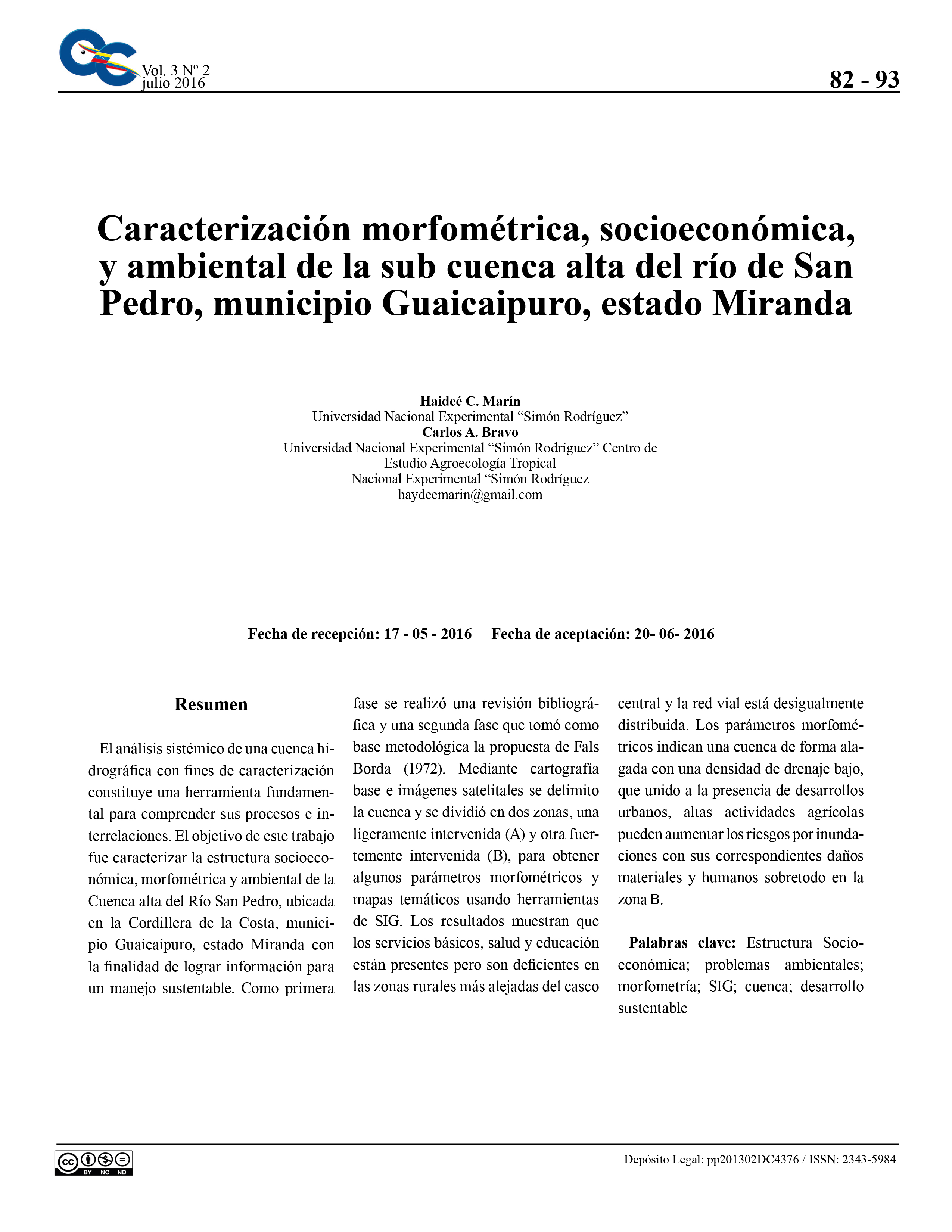Morphometric, socioeconomic, and environmental characterization of the upper sub-basin of the San Pedro river, Guaicaipuro municipality, Miranda state
Keywords:
Socioeconomic structure, environmental problems, morphometry, GIS, watershed, sustainable developmentAbstract
The systemic analysis of a river basin for characterization purposes is a fundamental tool for understanding its processes and interrelations. The objective of this work was to characterize the socioeconomic, morphometric and environmental structure of the high basin of San Pedro River, located in the Coastal Mountain Range, Guaicaipuro municipality, Miranda State, in order to obtain information for a sustainable management. As a first phase, a bibliographic review was carried out and a second phase that took as a methodological basis the proposal of Fals Borda (1972). Using base cartography and satellite images, the basin was delimited and divided into two zones, one slightly intervened (A) and another strongly intervened (B), to obtain some morphometric parameters and thematic maps using GIS tools. The results show that basic services, health and education are present but are deficient in the rural areas farthest from the central area and the road network is unevenly distributed. The morphometric parameters indicate a basin with a low drainage density, which together with the presence of urban development, high agricultural activities can increase the risk of flooding with its corresponding material and human damage, especially in zone B.
Downloads
References
Barrow C (1998) River basin development planning and management: a critical review. World Development 26(1): 171-186.
González, J. (1995). Guía metodológica para el estudio integral de Cuencas Hidrológicas Superficiales con Proyección de Manejo.Ciudad de La Habana, Cuba. Facultad de Geografía, Universidadde La Habana.
Díaz, Luís E. (1997): “Resumen Cronológico de desarrollo histórico de San Pedro y El Jarillo”, 1era. Edición, Publicaciones del Autor (cronista), San Pedro de los Altos, 20 Pág.
Donell JJ, Woods R (2004) On the need of catchment classification. Jornal of Hydrology 299: 2-3pp.
Diagnostico Biofísico y socioeconómico de la cuenta media alta del rio Coco http://www.sinia.net.ni/webayc2/biblioteca/Cuencashidrograficas/DiagnosticoCuenc MediaAltaRioCoco.pdf
Horton, R. (1945): “Erosional development of streams and their drainage basins; hidrophysical aproach to quantitative morphology”. Bull. Geol. Soc. Am. 56, 275-370.
Campos, A. (1992). Proceso del Ciclo Hidrológico. Universidad Autónoma de San Luis Potosí. 1ª ed. San Luis Potosí, México.22-23 p.
Verdin KL, Verdin JP (1999) A topological system for delineation and codification of the Earths’s river basins. Jornal of Hydrology 218: 1-12pp.
Martín, G. (2001): Diagnóstico ambiental de la Cuenca del río Máximo con un enfoque hacia el manejo integrado de la zona costera. (Inédito). Universidad de Camaguey. Tesis presentada en opción al grado académico de Master en Desarrollo Regional. Camaguey, 2001.
Fals Borda, O (1972). Taller teórico-práctico sobre el método de Investigación Acción Participativa, Materia de circulación interna Bogotá. Documento mimeografiado Guido E, Busnelli M (1993) Criterios morfométricos para la evaluación de la torrencialidad de una cuenca hídrica (Río Las Cataras, Catamarca. XII Congreso Geológico Argentino y II
Congreso de Exploración de Hidrocarburos en Mendoza. Vol. 6: 116-122.
Ortiz, L. (2004) Evaluación hidrológica en Revista Hidro Red, Red Latinoamericana de Micro Hidroenergía, Lima Perú. Vol. (2): 2-10.
Sosa de León, Mireya (1993): “San Pedro de los Altos: La crisis del café en Venezuela”, Biblioteca de autores y temas Mirandinos, Los Teques, 157 Pág.
Shumm, S. (1956) The fluvial system. A Wiley-interscience Publication. John Wiley and Sons, Inc. New York. 338 p.
Miller, V. (1953). A quantitative geomorphic study of drainage basin characteristics in the Clinch Mountain area Virginia and Tenessee. Office of Naval Research, Geography Branch, Proyect NR 381-042, Techical Report, 3, Columbia University.
Veitia, G., Malapina H. (1994): “Diagnostico Geográfico de la Parroquia San Pedro, Estado Miranda, con fines de Ordenamiento Espacial”, Trabajo Especial de Grado, para optar al Título de Geógrafo. Universidad Central de Venezuela-Instituto Nacional de Estadística
(INE), República Bolivariana de Venezuela “Censo 2001”, XIII Censo General de Población y Vivienda (Redatam) [En Línea]., Disponible en: http://www.ine.gob.ve/poblacion/index.html.
Léxico Estratigráfico de Venezuela (L.E.V.),1999 (Versión Electrónica). http://www.pdv.com/lexico [Consulta: 30 Julio, 2012]
Gobernación del estado Miranda. (2009). Anuario Estadístico del estado bolivariano de Miranda.
Gobernación del estado Miranda. (2011). Plan de ordenamiento territorial. [En Línea].. Disponible en: Díaz, Keissy .(2002). Estudio de impacto ambiental. Metro de los Teques: Tramo las Adjunta los Teques Revista Geografía de Venezuela. Vol. 43(1), 77-96.

Downloads
Published
How to Cite
Issue
Section
License

This work is licensed under a Creative Commons Attribution-NoDerivatives 4.0 International License.







